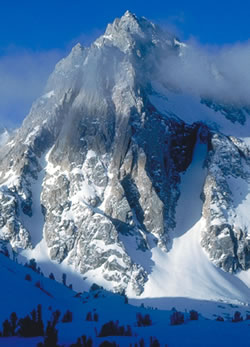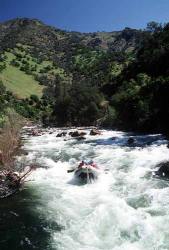 Winter Precipitation Totals to Date:
Winter Precipitation Totals to Date:
The wet season for California has certainly started off with a bang! Rain and snow began falling in early October, and most ski areas opened up long before we were carving pumpkins and getting ready to hand out candy to the little kids of our neighborhoods.
November and December continued to add to the California rain and snow totals. By Christmas we had above average precipitation for the state. Just prior to the first of the year, a series of intense and powerful storms began. When the final storm left the region on January 10, several sites in the Sierra reported 22 feet or more of snow!
What does an "early" winter like this mean for the 2005, California rafting season? Good question. The answer is more involved than you might think and somewhat surprising.
A basic understanding of several concepts and terms is necessary before we come to any conclusions:
Rain and Snow
This is an easy one. We all understand that when it comes to precipitation, it either rains or snows. For most of us who live at lower elevations, we think of rain when we think of storms. For those who live at higher elevations, snow is what comes to mind when you say the word "storm" (After you have shoveled snow off a driveway once or twice, you wish it would rain instead of snow!).
Rain tends to either be soaked up by the ground immediately, or becomes run-off and ends up in streams, lakes, and reservoirs. Rain is certainly important to our existence and to that of every living thing around us, but when it comes to rafting, it is not the most important element in determining what water flows will be in California rivers during the spring, summer and fall.
Whitewater rivers in California are located in the foothills of high mountain ranges. These ranges above the rivers "catch" snow in the wintertime. Unlike the rain, snow "hangs around" for months and melts later on in the year when California enters its annual dry period. This "delayed" melt feeds California when it is needed most and is the main source of water for our rivers, lakes and reservoirs. The snowpack in the high country acts like a "bank" of water that receives deposits all winter long. In the hot spring and early summer months, lower elevations take withdrawals from this amazing water source.
Snow Water Content
Snow is the key to California water and "water content" is the key to snow. This term is one of the most important to understand when it comes to predicting water flows. As obvious as this might sound, snow contains water (it is, after all, made of water!). The amount of water contained in snow (water content) is the key factor that determines future flows and run-off. The higher the water content, the larger the amount of water and run-off when the snow eventually melts.
 One simple way to think about this concept is to imagine the snowpack in the high country as a giant white sponge. The size of the sponge is helpful to know, but the amount of water in the sponge is even more useful. Each year the strong heat of California's spring and summer act like two hands that squeeze the sponge and extract all of its water. The amount that comes out (water content) is what we get downstream.
One simple way to think about this concept is to imagine the snowpack in the high country as a giant white sponge. The size of the sponge is helpful to know, but the amount of water in the sponge is even more useful. Each year the strong heat of California's spring and summer act like two hands that squeeze the sponge and extract all of its water. The amount that comes out (water content) is what we get downstream.
Snow "depth" is not always a good measurement to use to determine future flows, because it does not indicate water content. There may be a thirty-foot deep snowpack in the Sierra, but the snow within the pack may be light and have a relatively low water content. This can occur when storms are cold and leave a very dry snow in the mountains. If temperatures between storms remain near freezing and surface snow does not melt and soak into snow below, the pack will remain light and have a low water content. When a dry snowpack like this melts it may produce less water than a twelve-foot deep snowpack with heavy wet snow and significant water content.
Water Content in the California Snowpack as of January 24, 2005:
The good news is that right now California water content for the central part of the state is 124% of average for this date and 87% of total for the year. The southern part of the state is even better off at 205% average for this date and 106% of the average total for the year. This means that if no more storms came into California for the rest of winter and spring, we would have 87% to 106% of the water we need. If more storms do arrive, it is only going to get better. The current winter and water year is certainly off to a good start. The remarkable thing is that we still have two typically wet months (February and March) ahead of us! To view the State's water content charts, go to:
http://cdec.water.ca.gov/cgi-progs/products/PLOT_SWC.2005.pdf
Spring Rafting 2005:
 Determining what rivers will be doing this spring is more difficult than determining how much water we will have once the snow melts. This is true because springtime flows are an issue of timing and water content. When the snow melts becomes a key factor for spring flows, especially if you are considering a free-flowing, non dam-controlled river. If March and April are extremely warm and dry like they were in 2004, the rivers will run high in these early months as the snow melts. By the time we get to the second and third month of the rafting season (May and June) the rivers will have "used up" most of the water from the melted snowpack and will not be flowing high and fast as they normally do. On the other hand, if March and April are cold, high flows will come later in May, June, and as late as early July as the high county heats up and water is released to lower elevations.
Determining what rivers will be doing this spring is more difficult than determining how much water we will have once the snow melts. This is true because springtime flows are an issue of timing and water content. When the snow melts becomes a key factor for spring flows, especially if you are considering a free-flowing, non dam-controlled river. If March and April are extremely warm and dry like they were in 2004, the rivers will run high in these early months as the snow melts. By the time we get to the second and third month of the rafting season (May and June) the rivers will have "used up" most of the water from the melted snowpack and will not be flowing high and fast as they normally do. On the other hand, if March and April are cold, high flows will come later in May, June, and as late as early July as the high county heats up and water is released to lower elevations.
It is too early to tell what level water flows will be in the springtime, but the high water content makes it more likely that flows will be good this spring in California . We will continue to watch California water content as it develops, along with temperatures in the high elevations, and keep you posted.
Summer Rafting 2005:
Determining what rivers will be doing in the summer is fairly easy. Most summer time runs occur on rivers that have regulated flows from up-stream, dam-controlled reservoirs. These rivers "catch" water from snowmelt whether it happens early in March, or late in June. Water content becomes the big issue with these rivers. If the winter produces snow with a high water content these dam-controlled rivers will run well.
It is fair and reasonable to say at this time that dam-controlled rivers should be running well for this coming season. The high water content at this time means that reservoirs will fill once water is released from melting snow. With full reservoirs, dam releases will be good through the summer months and into the fall. More snowfall in the high country during the next few months will mean higher and longer flows on dam-controlled rivers in 2005.
We hope this article has been helpful in giving you a better understanding of what this early winter means for the upcoming California rafting season. Of course, if you have any questions you may contact us by e-mail or by phone and we will be happy to answer your questions and give you any new updated information we have regarding this season and flows. We look forward to rafting with you on any one of 10 California rivers.
Gregg Armstrong
Owner All-Outdoors California Whitewater Rafting
 Winter Precipitation Totals to Date:
Winter Precipitation Totals to Date: